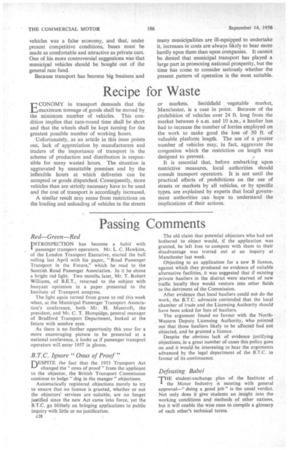Recipe for Waste
Page 78

If you've noticed an error in this article please click here to report it so we can fix it.
CONOMY in transport demands that the maximum tonnage of goods shall be moved by the minimum number of vehicles. This condition implies that turn-round time shall be short and that the wheels shall be kept turning for the greatest possible number of working hours.
Unfortunately, as an article in this issue points out, lack of appreciation by manufacturers and traders of the importance of transport in the scheme of production and distribution is responsible for many wasted hours. The situation is aggravated by unsuitable premises and by the inflexible hours at which deliveries can be accepted or goods dispatched. Consequently, more vehicles than are strictly necessary have to be used and the cost of transport is accordingly increased.
A similar result may ensue from restrictions on the loading and unloading of vehicles in the streets or markets. Smithfield vegetable market, Manchester, is a case in point. Because of the prohibition of vehicles over 24 ft. long from the market between 6 a.m. and 10 a.m., a haulier has had to increase the number of lorries employed on the work to make good the loss of 50 ft. of valuable platform length. The use of a greater number of vehicles may, in fact, aggravate the congestion which the restriction on length was designed to prevent.
It is essential that, before embarking upon restrictive measures, local authorities should consult transport operators. It is not until the practical effects of prohibitions on the use of streets or markets by all vehicles, or by specific types, are explained by experts that local government authorities can hope to understand the implications of their actions.












































































































































































































